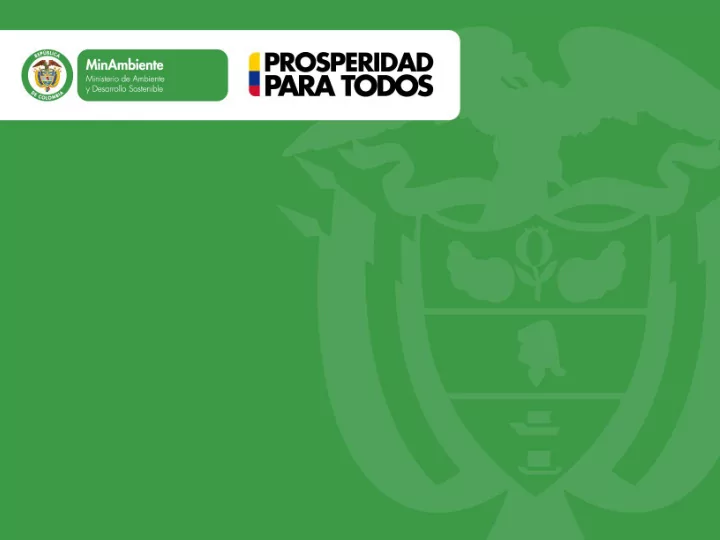

Título Subtítulo o texto necesario
Promising NAMAs in Latin America Presentation by Colombia Maria Paula Mendieta Ministry of Environment and Sustainable Development
Colombia Climate Change Strategy The National Development Plan 2010-2014 established the need to enhance action in mitigation and adaptation to climate change. A policy document (CONPES 3700 of 2011) established the institutional and main policies for national climate change action.
Objectives of the CLDS Achieve the same level of expected growth while maintaining GHG emissions stable. The ECDBC aims to design along with the sectors and regions sector-based plans which include technology transfer needs and identification of barriers and opportunities for identified mitigation actions. NAMAs will be part of the CLCDS
Solid Waste NAMA Background: Colombian waste sector • 2003 – A two year period was established for regional authorities to close any dumps or inadequate waste disposal sites. • Today: most of the final disposal has shifted towards landfilling. 100% 93% 93% 93% 90% 81% 80% 70% 60% Ton/d in adequate TON / DIA EN SITIOS disposal sites 50% ADECUADOS 40% TON / DIA EN SITIOS Ton/d in inadequate NO ADECUADOS 30% disposal sites 19% 20% 7% 7% 7% 10% 0% 2006 2008 2009 2010 Figure 1. Final disposal in Colombia 2006 - 2010. Source: Colombian Ministry of Housing, City and Territory.
Challenges • Low energy prices of the Colombian grid (hydro-power based). – Low GHG emission reduction potential Electricity Waste (relatively clean energy grid). Generatio water n 12% 4% Composti Capture ng 8% and • No incentive for use of biogas as a source of Flaring of Lanfill renewable energy. Biogas 75% • Waste collection tariffs are charged by amount of waste disposed . – No incentives for waste reduction at the Figure 2. Type of project within the waste sector in the Colombian CDM portfolio. source, recycling or reuse. • Growing informal recycling sector
Workshop March, 2012 Defined national priorities and convened to understand public, private, and NGO stakeholders needs Department of National Planning, Superintendence Steering for Household Services, Ministry of Environment Committee and Sustainable Development, Ministry of Housing, City and Territory Waste Package of measures that NAMA Selection of target various stages of the technology pilot cities waste stream alternatives Perform techno-economic feasibility and analyze Feasibility GHG benefits of alternative technologies and Studies March, 2013 processes
Potentially Viable Technologies and Processes based on Scoping Study Supporting Factors RDF • Potential for tariff reform • Strong interest shown Mixed Waste Recyclables from Argos Cement Co MBT Facility • Robust recyclables market Compost • Transport cost savings potential Landfill Landfills that Gas to • Gas collection is already in place are currently Energy flaring
Institutional Arrangements National Climate Change System CLCDS NAP REDD Sectorial Mitigation Plans National: Steering Committee Waste NAMA Local: Private, Public sector arrangements
Next Steps 1. Perform techno-economic feasibility and analyze GHG benefits of alternative technologies and processes (source separation, MBT for RDF, composting etc.) in two cities (Cali and Sogamoso) as pilot locations 2. Analyze drivers of commodity markets linked to waste management such as recyclables, compost, RDF etc. 3. Analyze impact of tariff reform 4. Provide recommendations on strategies for inclusion of informal sector in the integrated waste management plans 5. Scale up city-level analyses to design a comprehensive integrated waste management NAMA for Colombia with details on unilateral and supported components
Transit Oriented Development NAMA Background: • Transport is a big challenge for our cities. • Each city in Colombia has to have a Land use plan (POT). • Transport represents 12% of national GHG emissions. Benefits: • Air quality/health • Traffic • Travel time Objective: Achieve emissions reductions by including climate change mitigation criteria into land use urban planning. Promote or ensure different uses in areas around public transport infrastructure/stations. Increase the use nonmotorized transportation.
NAMA developing process • National Agencies Involved: Ministry of Transport National Planning Department Ministry of Housing Ministry of Environment • Local governments Members of some of these institutions visited Washington D.C. to learn about the concept of TOD and all were interested. Some cities (Bogota and Cali) have identified projects or areas were the concept of TOD could be introduced.
Next Steps • Formalize a committee/group of national and local agencies to work on approving the design of the NAMA and related studies. • Build additional institutional arrangements required for developing and implementing the NAMA. • Studies for specific pilot cities such as Cali and Bogota (baselines, mitigation potential, other benefits, costs, etc.) • Identify possible sources of finance for the NAMA • Build a NAMA proposal
Muchas Gracias
Recommend
More recommend